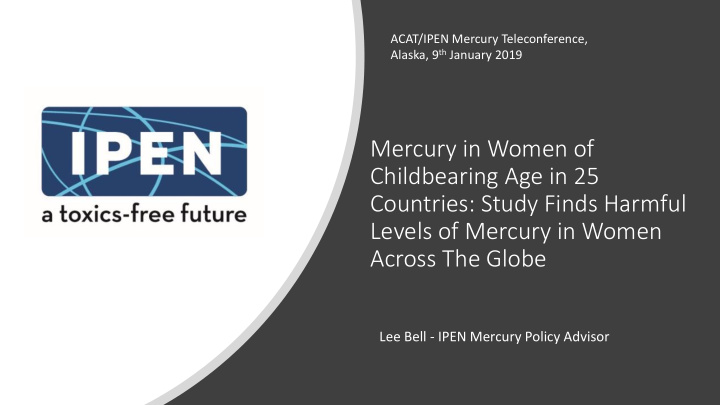



ACAT/IPEN Mercury Teleconference, Alaska, 9 th January 2019 Mercury in Women of Childbearing Age in 25 Countries: Study Finds Harmful Levels of Mercury in Women Across The Globe Lee Bell - IPEN Mercury Policy Advisor
Mercury highly toxic to human health • Mercury is a potent neurotoxic metal that is especially damaging to the developing brain and can affect the developing fetus months after the mother’s exposure. • The harmful effects of mercury, that can pass from a mother’s body to a developing fetus, include neurological impairment, IQ loss, and damage to the kidneys and cardiovascular system. • High levels of mercury exposure can lead to brain damage, mental retardation, blindness, seizures and the inability to speak.
• In 2001 the Governing Council of the UN requested that UNEP undertake a global study of mercury pollution impacts, health effects long range transport and control measures. • In February 2009 the Governing Council decided that current measures to control global mercury pollution were insufficient The Minamata and that a globally legally binding instrument was required. • An international negotiating committee (INC) was formed to Convention on allow countries to negotiate and develop the text for a Convention. Mercury – some • Over the course of 7 INC meetings, text was developed and at INC 7 in Jordan, draft text for the convention was finalised. background • On the 10th October 2013, at a Conference of Plenipotentiaries (Diplomatic Conference) in Kumamoto, Japan, the Convention was adopted and opened for signature. • The Minamata Convention required 50 ratifications to enter into force and this occurred on 16 August 2017. • Since that time the Conference of the Parties have met twice – COP 1 in Geneva in September 2017 and COP 2 in Geneva in November 2018.
Objective: Protection of human health from man made mercury pollution. • Seeks major reductions and control on the global supply Key Features and trade of mercury • Phase-out and substitution of mercury-added products of the • Measures to eliminate the use of mercury in small scale gold mining Minamata • Tighter controls on mercury emissions and releases from industrial processes such as coal burning for energy, Convention cement kilns, chlor-alkali plants and metallurgy • Banning the mining of mercury and related compounds (cinnabar ) • Definition and controls on mercury waste • Identification of contaminated sites
Establishment or reorganisation of expert groups developing guidance on: • Mercury waste thresholds; • Contaminated Sites • Effectiveness evaluation and harmonised framework development for air, soil and water sampling as well as biomonitoring. • Mercury Releases – A controversial issue with inventory guidance development preceding guidance on reducing releases. • Specific international program (SIP) for funding of mercury pollution reduction, technology Outcomes of COP 2 transfer and capacity building now established but for parties only.
Key sources of f Hg pollution- ASGM and Coal burning
Global Hg emissions surge 20% in 5 years. 2010-2015
Global mercury pollution cycles
IP IPEN mercury ry biomonitoring
Mercury pollution in Alaska Global distillation processes result in volatile contaminants such as persistent organic pollutants and mercury depositing at northern latitudes, contaminating wildlife, seafood and the food chain.
Biomonitoring in St Lawrence Island, Alaska
Alaska
Selected IPEN global report data including St. Lawrence Island, Alaska
Food chain impacts: Seals, salmon walrus and whales.
Age related factors
• Diet and age key factors in Hg accumulation. • Frequency of consumption of seal meat a significant factor • Walrus less likely to accumulate mercury • Sockeye salmon not heavily contaminated • Data on halibut limited but larger fish (>40 pounds) will have higher accumulation levels of mercury than younger fish. • Consideration of combined POPs and Hg contamination is an issue. Conclusions
Recommend
More recommend